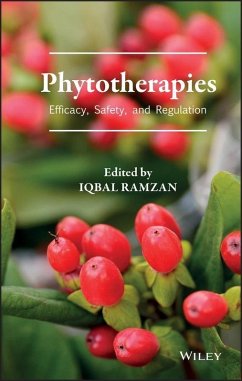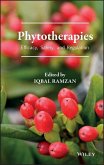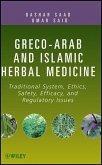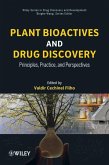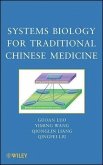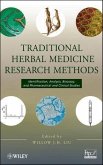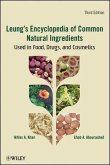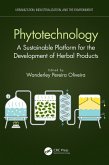Phytotherapies (eBook, ePUB)
Efficacy, Safety, and Regulation
Redaktion: Ramzan, Iqbal


Alle Infos zum eBook verschenken

Phytotherapies (eBook, ePUB)
Efficacy, Safety, and Regulation
Redaktion: Ramzan, Iqbal
- Format: ePub
- Merkliste
- Auf die Merkliste
- Bewerten Bewerten
- Teilen
- Produkt teilen
- Produkterinnerung
- Produkterinnerung

Hier können Sie sich einloggen

Bitte loggen Sie sich zunächst in Ihr Kundenkonto ein oder registrieren Sie sich bei bücher.de, um das eBook-Abo tolino select nutzen zu können.
Covering fundamentals and new developments in phytotherapy, this book combines pharmaceutical sciences and chemistry with clinical issues. . Helps readers better understand phytotherapy and learn the fundamentals of and how to analyze phytotherapeutic agents . Discusses phytotherapy in modern medicine, chemoprevention of disease, and alternatives to western medicines for specific diseases . Chapters summarizes the uses and applications of phytomedicines, by type like Chinese, Greco-Arab, Indian, European, and Ayurvedic . Includes international regulatory perspectives and discusses emerging regulations for various established and emerging markets…mehr
- Geräte: eReader
- ohne Kopierschutz
- eBook Hilfe
![Phytotherapies (eBook, PDF) Phytotherapies (eBook, PDF)]() Phytotherapies (eBook, PDF)171,99 €
Phytotherapies (eBook, PDF)171,99 €![Greco-Arab and Islamic Herbal Medicine (eBook, ePUB) Greco-Arab and Islamic Herbal Medicine (eBook, ePUB)]() Bashar SaadGreco-Arab and Islamic Herbal Medicine (eBook, ePUB)143,99 €
Bashar SaadGreco-Arab and Islamic Herbal Medicine (eBook, ePUB)143,99 €![Plant Bioactives and Drug Discovery (eBook, ePUB) Plant Bioactives and Drug Discovery (eBook, ePUB)]() Valdir Cechinel-FilhoPlant Bioactives and Drug Discovery (eBook, ePUB)170,99 €
Valdir Cechinel-FilhoPlant Bioactives and Drug Discovery (eBook, ePUB)170,99 €![Systems Biology for Traditional Chinese Medicine (eBook, ePUB) Systems Biology for Traditional Chinese Medicine (eBook, ePUB)]() Guoan LuoSystems Biology for Traditional Chinese Medicine (eBook, ePUB)170,99 €
Guoan LuoSystems Biology for Traditional Chinese Medicine (eBook, ePUB)170,99 €![Traditional Herbal Medicine Research Methods (eBook, ePUB) Traditional Herbal Medicine Research Methods (eBook, ePUB)]() Traditional Herbal Medicine Research Methods (eBook, ePUB)143,99 €
Traditional Herbal Medicine Research Methods (eBook, ePUB)143,99 €![Leung's Encyclopedia of Common Natural Ingredients (eBook, ePUB) Leung's Encyclopedia of Common Natural Ingredients (eBook, ePUB)]() Ikhlas A. KhanLeung's Encyclopedia of Common Natural Ingredients (eBook, ePUB)148,99 €
Ikhlas A. KhanLeung's Encyclopedia of Common Natural Ingredients (eBook, ePUB)148,99 €![Phytotechnology (eBook, ePUB) Phytotechnology (eBook, ePUB)]() Phytotechnology (eBook, ePUB)49,95 €
Phytotechnology (eBook, ePUB)49,95 €-
-
-
Dieser Download kann aus rechtlichen Gründen nur mit Rechnungsadresse in D ausgeliefert werden.
- Produktdetails
- Verlag: Wiley-IEEE Press
- Erscheinungstermin: 17. April 2015
- Englisch
- ISBN-13: 9781119006237
- Artikelnr.: 42687264
- Verlag: Wiley-IEEE Press
- Erscheinungstermin: 17. April 2015
- Englisch
- ISBN-13: 9781119006237
- Artikelnr.: 42687264
- Herstellerkennzeichnung Die Herstellerinformationen sind derzeit nicht verfügbar.
Ping Yau, Cheong Hian Goh, and Hwee
Ling Koh 2.1 Introduction 18 2.2 Key Considerations in QC/QA of Phytomedicines 20 2.3 Methods for QC/QA of Phytomedicines 27 2.4 Challenges 37 2.5 Conclusions 40 References 40 3 Preclinical (In Vivo) and Laboratory (In Vitro) Evidence of Phytomedicine Efficacy 49 Mohi Iqbal Mohammed Abdul and Tom Hsun
Wei Huang 3.1 Introduction to Development of Drugs from Nature 49 3.2 Use of In Vitro and in Vivo Models in Herb Drug Research: Learning Thus Far 50 3.3 Cardiovascular
and Stroke
Related Diseases: In Vitro and In Vivo Focus 53 3.4 Conclusions 60 References 61 4 Clinical Efficacy Trials with Natural Products and Herbal Medicines 65 Christina L. Nance 4.1 Introduction 65 4.2 Trials in Various Disease States 66 4.3 Natural Product: Green Tea 73 4.4 EGCG Clinical Trials 75 4.5 Human Clinical Study: EGCG and HIV
1 Infection 78 4.6 Conclusion 80 References 80 5 Novel Formulations and Drug Delivery Systems for Phytotherapies 89 Shengpeng Wang, Meiwan Chen, Qi (Tony) Zhou, and Hak
Kim Chan 5.1 Limitations of Conventional Formulations for Herbal Medicines 89 5.2 Crucial Issues of Developing Novel Delivery Systems for Herbal Medicines 91 5.3 Novel Delivery Systems of Herbal Medicines 93 5.4 Summary 96 References 97 6 Phytotherapies Used by Indigenous Populations 101 Bradley S. Simpson and Susan J. Semple 6.1 Introduction 101 6.2 Phytotherapies of Indigenous Australians 103 6.3 Challenges of a Changing Environment 114 6.4 Conclusions 117 References 118 7 Phytotherapies from Traditional Chinese Medicine 122 Michael Rieder 7.1 Traditional Chinese Medicine 122 7.2 Key Concepts in Traditional Chinese Medicine 124 7.3 Herbal Medicine and Traditional Chinese Medicine 126 7.4 Issues in the Development of Phytotherapy from Traditional Chinese Medicine 130 7.5 Phytotherapies Developed from Traditional Chinese Medicine 131 7.6 Huang Qin Tang and the Development of PHY906 134 7.7 Ginseng 136 7.8 Moving Forward 138 References 138 8 Integrating Traditional Greco
Arab and Islamic Diet and Herbal Medicines in Research and Clinical Practice 142 Bashar Saad 8.1 Introduction 142 8.2 Food Therapy in Greco
Arab and Islamic Medicine 147 8.3 Medicinal Plants 157 References 177 9 Evolution of Herbal Medicines in Europe and its Relationship with Modern Medicine 183 Elizabeth M. Williamson and Kelvin Chan 9.1 Background 183 9.2 Historical Perspective 184 9.3 European Herbal Medicine: Relationship with Modern Medicine 194 9.4 Summary 194 References 196 10 Chemical Classification and Chemistry of Phytotherapeutics Constituents 199 Pei H. Cui and Colin C. Duke 10.1 Introduction 199 10.2 Phytochemicals 201 10.3 Other Phytochemicals 215 10.4 Medicinal Effects Relating to Dietary Intake 217 10.5 Natural Products as Leads for Drug Development 223 10.6 Summary 230 References 230 11 Therapeutic Potential of Ginsenosides in Management of Atherosclerosis 236 Xiao
Jing Zhang, Huanxing Su, Yi-Tao Wang, and Jian-Bo Wan 11.1 Introduction 236 11.2 Chemical Diversity of Ginsenosides and Distribution 238 11.3 Anti
Atherosclerotic Effects of Ginsenosides 240 11.4 Underlying Mechanisms of Ginsenosides Against Atherosclerosis 244 11.5 Conclusions and Future Perspectives 258 Acknowledgments 258 References 258 12 Phytotherapy Pharmacophores for Major Cellular Drug Targets 268 Jennifer A. Ong, Paul W. Groundwater, and David E. Hibbs 12.1 Introduction 268 12.2 What is a Pharmacophore? 269 12.3 Pharmacophore Models of Cardiovascular Drugs 270 12.4 Pharmacophore Models for Anticancer Drugs 285 12.5 Pharmacophore Models for Anti
Inflammatory Drugs 290 12.6 Pharmacophore Models for Anti
Infective Drugs 297 12.7 Pharmacophore Models for Neurological Drugs 299 12.8 Pharmacophore Models for Miscellaneous Drugs 305 12.9 Conclusions 309 References 309 13 Use of Kava as a Phytotherapeutic Agent and KaväRelated Hepatotoxicity 312 Dong Fu and Iqbal Ramzan 13.1 Introduction 312 13.2 Active Components in Kava 313 13.3 Therapeutic Applications of Kava 314 13.4 Pharmacology of Kava 314 13.5 Side Effects of Kava 317 13.6 Hepatotoxicity of Kava 318 13.7 Summary and Future Challenges 322 References 323 14 Phytotherapies as New Drug Sources: Gossypol and Curcumin 330 Vivian Wan Yu Liao, Rajeshwar Narlawar, David E. Hibbs, and Paul W. Groundwater 14.1 Botanical Sources of Gossypol and Curcumin 330 14.2 Stereoisomerism, Tautomerism, and Reactivity 332 14.3 Biological Activity of Gossypol and its Analogues 337 14.4 Biological Activity of Curcumin and its Analogues 346 References 360 15 Phytotherapies for the Management of Obesity and Diabetes 370 Michel Rapinski and Alain Cuerrier 15.1 Introduction 370 15.2 Plants from the North American Pharmacopoeia 372 15.3 Pharmacological Screening: Providing Empirical Evidence for Phytotherapies 379 15.4 Community
Based Participation: Developing Phytotherapies from Traditional Knowledge 385 15.5 Conclusions 387 References 387 16 Phytotherapeutics for Cancer Therapy 394 Daniel M.
Y. Sze, Hao Liu, Maureen V. Boost, Raimond Wong, and Stephen Sagar 16.1 Introduction 394 16.2 Anticancer Phytotherapeutics With NK Enhancement 395 16.3 Conclusions 423 References 425 17 Phytomedicines for Fatty Liver Disease and Functional Gastrointestinal Conditions 429 George Q. Li, Moon
Sun Kim, Fangming Jin, and Jun
Lae Cho 17.1 Introduction 429 17.2 Phytomedicines for FLD 430 17.3 Phytomedicines for IBS 439 17.4 Phytomedicines for Constipation 444 17.5 Summary and Future Perspectives 448 References 448 18 Phytomedicines for Inflammatory Conditions 464 Sigrun Chrubasik
Hausmann 18.1 Traditional Medicines for Inflammatory Conditions in Europe 464 18.2 Twenty
First
Century Update on Paids 465 18.3 Oral Extracts from Salix Species 465 18.4 Oral Extracts from Harpagophytum procumbens 468 18.5 Oral Avocado-Soybean Unsaponifiables 469 18.6 Oral Extracts From Tripterygium wilfordii 473 18.7 Oral Paids Containing Unsaturated Fatty Acids 475 18.8 Other Oral Paids 476 18.9 Topical Paids 477 References 478 19 Phytotherapies for Infectious Diseases: Are These Really Useful? 483 Gail B. Mahady, Gabrielle Escalante, Pooja Mikkilineni, Laura J. Mahady, Temitope O. Lawal, and Bolanle A. Adeniyi The History of Medicine 483 19.1 Introduction 484 19.2 Historical Precedent for Natural Products as Antimicrobial Drugs 486 19.3 Are Phytotherapies Useful for the Treatment of Infectious Diseases? 487 19.4 Naturally Occurring Compounds that may Reduce Zoonosis 495 19.5 Synergistic and Additive Effects with Antibiotics 496 19.6 New Emerging Infectious Diseases and those with no Known Treatments 496 19.7 SARS 497 19.8 Reducing MRSA Carriage 498 19.9 Conclusions 499 References 500 20 Phytomedicines for CNS Disorders: Safety Issues for use with Antiepileptic Drugs 504 Sophia Yui Kau Fong, Rosina Yau Mok, Qiong Gao, Yin Cheong Wong, and Zhong Zuo 20.1 Introduction 504 20.2 Methodology of Systematic Literature Search 506 20.3 Pharmacokinetic Interactions 506 20.4 Pharmacodynamic Interactions 512 20.5 Conclusions 524 References 524 21 Phytotherapies: Drug Interactions in Cancer 536 Andrew J. McLachlan and Stephen J. Clarke 21.1 Introduction 536 21.2 Use of Herbal and Complementary Medicines by People Living with Cancer 537 21.3 Mechanisms of Phytotherapy-Drug Interactions 538 21.4 Selected Examples of Phytotherapy Medicines that have the Potential to Cause Drug Interactions in Cancer 540 21.5 Future Perspectives: Need for Evidence and Advice to Cancer Patients and Physicians 546 21.6 Conclusions 547 Acknowledgments 547 Conflict of Interest 547 References 547 22 Quality Use of Medicines: Considerations in Phytotherapy 554 Lynn Weekes 22.1 Introduction 554 22.2 Relevance of Qum for Herbal Medicines 556 22.3 Use of Phytotherapies by Consumers 558 22.4 Consumer Attitudes and Beliefs about Herbal Medicines 559 22.5 Applying the Qum Framework to Phytotherapies 561 22.6 Building Blocks for Quality Use of Herbal Medicines 566 22.7 Conclusion 570 References 570 23 Intellectual Property and Patent Issues with Phytotherapy Products 573 Gint Silins, Jennifer Tan, and Kelvin Chan 23.1 Introduction 573 23.2 IP Rights-Phyto
Industry 575 23.3 Brief Overview of Patents and the Patenting Process 578 23.4 Other Types of IP Rights 585 23.5 Patenting Trends for Phytotherapeutics 587 23.6 Traditional Knowledge and IP Rights 587 Disclaimer 589 References 590 24 International Regulatory Status of Phytotherapies 593 Ernest V. Linek 24.1 Introduction 593 24.2 Specific Country Regulations 596 24.3 Future of Phytotherapies: World Health Organization (WHO) 631 Further Reading 634 Index 635
Ping Yau, Cheong Hian Goh, and Hwee
Ling Koh 2.1 Introduction 18 2.2 Key Considerations in QC/QA of Phytomedicines 20 2.3 Methods for QC/QA of Phytomedicines 27 2.4 Challenges 37 2.5 Conclusions 40 References 40 3 Preclinical (In Vivo) and Laboratory (In Vitro) Evidence of Phytomedicine Efficacy 49 Mohi Iqbal Mohammed Abdul and Tom Hsun
Wei Huang 3.1 Introduction to Development of Drugs from Nature 49 3.2 Use of In Vitro and in Vivo Models in Herb Drug Research: Learning Thus Far 50 3.3 Cardiovascular
and Stroke
Related Diseases: In Vitro and In Vivo Focus 53 3.4 Conclusions 60 References 61 4 Clinical Efficacy Trials with Natural Products and Herbal Medicines 65 Christina L. Nance 4.1 Introduction 65 4.2 Trials in Various Disease States 66 4.3 Natural Product: Green Tea 73 4.4 EGCG Clinical Trials 75 4.5 Human Clinical Study: EGCG and HIV
1 Infection 78 4.6 Conclusion 80 References 80 5 Novel Formulations and Drug Delivery Systems for Phytotherapies 89 Shengpeng Wang, Meiwan Chen, Qi (Tony) Zhou, and Hak
Kim Chan 5.1 Limitations of Conventional Formulations for Herbal Medicines 89 5.2 Crucial Issues of Developing Novel Delivery Systems for Herbal Medicines 91 5.3 Novel Delivery Systems of Herbal Medicines 93 5.4 Summary 96 References 97 6 Phytotherapies Used by Indigenous Populations 101 Bradley S. Simpson and Susan J. Semple 6.1 Introduction 101 6.2 Phytotherapies of Indigenous Australians 103 6.3 Challenges of a Changing Environment 114 6.4 Conclusions 117 References 118 7 Phytotherapies from Traditional Chinese Medicine 122 Michael Rieder 7.1 Traditional Chinese Medicine 122 7.2 Key Concepts in Traditional Chinese Medicine 124 7.3 Herbal Medicine and Traditional Chinese Medicine 126 7.4 Issues in the Development of Phytotherapy from Traditional Chinese Medicine 130 7.5 Phytotherapies Developed from Traditional Chinese Medicine 131 7.6 Huang Qin Tang and the Development of PHY906 134 7.7 Ginseng 136 7.8 Moving Forward 138 References 138 8 Integrating Traditional Greco
Arab and Islamic Diet and Herbal Medicines in Research and Clinical Practice 142 Bashar Saad 8.1 Introduction 142 8.2 Food Therapy in Greco
Arab and Islamic Medicine 147 8.3 Medicinal Plants 157 References 177 9 Evolution of Herbal Medicines in Europe and its Relationship with Modern Medicine 183 Elizabeth M. Williamson and Kelvin Chan 9.1 Background 183 9.2 Historical Perspective 184 9.3 European Herbal Medicine: Relationship with Modern Medicine 194 9.4 Summary 194 References 196 10 Chemical Classification and Chemistry of Phytotherapeutics Constituents 199 Pei H. Cui and Colin C. Duke 10.1 Introduction 199 10.2 Phytochemicals 201 10.3 Other Phytochemicals 215 10.4 Medicinal Effects Relating to Dietary Intake 217 10.5 Natural Products as Leads for Drug Development 223 10.6 Summary 230 References 230 11 Therapeutic Potential of Ginsenosides in Management of Atherosclerosis 236 Xiao
Jing Zhang, Huanxing Su, Yi-Tao Wang, and Jian-Bo Wan 11.1 Introduction 236 11.2 Chemical Diversity of Ginsenosides and Distribution 238 11.3 Anti
Atherosclerotic Effects of Ginsenosides 240 11.4 Underlying Mechanisms of Ginsenosides Against Atherosclerosis 244 11.5 Conclusions and Future Perspectives 258 Acknowledgments 258 References 258 12 Phytotherapy Pharmacophores for Major Cellular Drug Targets 268 Jennifer A. Ong, Paul W. Groundwater, and David E. Hibbs 12.1 Introduction 268 12.2 What is a Pharmacophore? 269 12.3 Pharmacophore Models of Cardiovascular Drugs 270 12.4 Pharmacophore Models for Anticancer Drugs 285 12.5 Pharmacophore Models for Anti
Inflammatory Drugs 290 12.6 Pharmacophore Models for Anti
Infective Drugs 297 12.7 Pharmacophore Models for Neurological Drugs 299 12.8 Pharmacophore Models for Miscellaneous Drugs 305 12.9 Conclusions 309 References 309 13 Use of Kava as a Phytotherapeutic Agent and KaväRelated Hepatotoxicity 312 Dong Fu and Iqbal Ramzan 13.1 Introduction 312 13.2 Active Components in Kava 313 13.3 Therapeutic Applications of Kava 314 13.4 Pharmacology of Kava 314 13.5 Side Effects of Kava 317 13.6 Hepatotoxicity of Kava 318 13.7 Summary and Future Challenges 322 References 323 14 Phytotherapies as New Drug Sources: Gossypol and Curcumin 330 Vivian Wan Yu Liao, Rajeshwar Narlawar, David E. Hibbs, and Paul W. Groundwater 14.1 Botanical Sources of Gossypol and Curcumin 330 14.2 Stereoisomerism, Tautomerism, and Reactivity 332 14.3 Biological Activity of Gossypol and its Analogues 337 14.4 Biological Activity of Curcumin and its Analogues 346 References 360 15 Phytotherapies for the Management of Obesity and Diabetes 370 Michel Rapinski and Alain Cuerrier 15.1 Introduction 370 15.2 Plants from the North American Pharmacopoeia 372 15.3 Pharmacological Screening: Providing Empirical Evidence for Phytotherapies 379 15.4 Community
Based Participation: Developing Phytotherapies from Traditional Knowledge 385 15.5 Conclusions 387 References 387 16 Phytotherapeutics for Cancer Therapy 394 Daniel M.
Y. Sze, Hao Liu, Maureen V. Boost, Raimond Wong, and Stephen Sagar 16.1 Introduction 394 16.2 Anticancer Phytotherapeutics With NK Enhancement 395 16.3 Conclusions 423 References 425 17 Phytomedicines for Fatty Liver Disease and Functional Gastrointestinal Conditions 429 George Q. Li, Moon
Sun Kim, Fangming Jin, and Jun
Lae Cho 17.1 Introduction 429 17.2 Phytomedicines for FLD 430 17.3 Phytomedicines for IBS 439 17.4 Phytomedicines for Constipation 444 17.5 Summary and Future Perspectives 448 References 448 18 Phytomedicines for Inflammatory Conditions 464 Sigrun Chrubasik
Hausmann 18.1 Traditional Medicines for Inflammatory Conditions in Europe 464 18.2 Twenty
First
Century Update on Paids 465 18.3 Oral Extracts from Salix Species 465 18.4 Oral Extracts from Harpagophytum procumbens 468 18.5 Oral Avocado-Soybean Unsaponifiables 469 18.6 Oral Extracts From Tripterygium wilfordii 473 18.7 Oral Paids Containing Unsaturated Fatty Acids 475 18.8 Other Oral Paids 476 18.9 Topical Paids 477 References 478 19 Phytotherapies for Infectious Diseases: Are These Really Useful? 483 Gail B. Mahady, Gabrielle Escalante, Pooja Mikkilineni, Laura J. Mahady, Temitope O. Lawal, and Bolanle A. Adeniyi The History of Medicine 483 19.1 Introduction 484 19.2 Historical Precedent for Natural Products as Antimicrobial Drugs 486 19.3 Are Phytotherapies Useful for the Treatment of Infectious Diseases? 487 19.4 Naturally Occurring Compounds that may Reduce Zoonosis 495 19.5 Synergistic and Additive Effects with Antibiotics 496 19.6 New Emerging Infectious Diseases and those with no Known Treatments 496 19.7 SARS 497 19.8 Reducing MRSA Carriage 498 19.9 Conclusions 499 References 500 20 Phytomedicines for CNS Disorders: Safety Issues for use with Antiepileptic Drugs 504 Sophia Yui Kau Fong, Rosina Yau Mok, Qiong Gao, Yin Cheong Wong, and Zhong Zuo 20.1 Introduction 504 20.2 Methodology of Systematic Literature Search 506 20.3 Pharmacokinetic Interactions 506 20.4 Pharmacodynamic Interactions 512 20.5 Conclusions 524 References 524 21 Phytotherapies: Drug Interactions in Cancer 536 Andrew J. McLachlan and Stephen J. Clarke 21.1 Introduction 536 21.2 Use of Herbal and Complementary Medicines by People Living with Cancer 537 21.3 Mechanisms of Phytotherapy-Drug Interactions 538 21.4 Selected Examples of Phytotherapy Medicines that have the Potential to Cause Drug Interactions in Cancer 540 21.5 Future Perspectives: Need for Evidence and Advice to Cancer Patients and Physicians 546 21.6 Conclusions 547 Acknowledgments 547 Conflict of Interest 547 References 547 22 Quality Use of Medicines: Considerations in Phytotherapy 554 Lynn Weekes 22.1 Introduction 554 22.2 Relevance of Qum for Herbal Medicines 556 22.3 Use of Phytotherapies by Consumers 558 22.4 Consumer Attitudes and Beliefs about Herbal Medicines 559 22.5 Applying the Qum Framework to Phytotherapies 561 22.6 Building Blocks for Quality Use of Herbal Medicines 566 22.7 Conclusion 570 References 570 23 Intellectual Property and Patent Issues with Phytotherapy Products 573 Gint Silins, Jennifer Tan, and Kelvin Chan 23.1 Introduction 573 23.2 IP Rights-Phyto
Industry 575 23.3 Brief Overview of Patents and the Patenting Process 578 23.4 Other Types of IP Rights 585 23.5 Patenting Trends for Phytotherapeutics 587 23.6 Traditional Knowledge and IP Rights 587 Disclaimer 589 References 590 24 International Regulatory Status of Phytotherapies 593 Ernest V. Linek 24.1 Introduction 593 24.2 Specific Country Regulations 596 24.3 Future of Phytotherapies: World Health Organization (WHO) 631 Further Reading 634 Index 635
